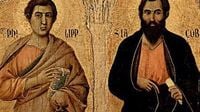On Saturday, May 3, 2025, the Catholic Church commemorates the lives of several saints, with a notable focus on San Felipe Apóstol. Felipe, one of the twelve apostles chosen directly by Jesus of Nazareth, is remembered for his close relationship with the Master and his significant role in spreading the Christian faith.
San Felipe is consistently listed as the fifth apostle in the synoptic gospels. Following the crucifixion and ascension of Jesus, he undertook missionary work throughout Asia Minor, bringing the message of the Gospel to new lands. According to apocryphal accounts, he was arrested and ultimately martyred in Hierápolis, located in the region of Frigia (now part of Turkey), around the year 80 AD.
Today, the Catholic Church celebrates not only San Felipe but also several other saints including Alejandro I, Ansfrido, Conleto, Juvenal, Maura de Antinoe, Pedro de Argo, Santiago el Menor, Teodosio de Kiev, Timoteo de Antinoe, Ventura de Spello, and Violeta. These names are drawn from the Roman Martyrology, a catalogue updated by the Vatican to include canonizations that take place each year.
The tradition of celebrating saints has deep roots in Catholic culture, particularly in Spain, where it has become an integral part of daily life. The onomastics, or the day dedicated to celebrating a particular saint, is a way for the faithful to commemorate those who have exemplified virtuous lives and have often faced persecution for their faith.
San Felipe, in particular, is revered for his contributions to the early Church. He is known for his role in the Gospel of John, where he assists in guiding others to Christ, such as when he brought Nathanael to meet Jesus. His preaching extended to regions like Frigia, and according to tradition, he died a martyr in Hierápolis.
In addition to Felipe, the Catholic Church honors other significant figures today. San Alejandro I, a pope and martyr from the 2nd century, is celebrated for introducing holy water and mixing it with wine during Mass. San Ansfrido, a 10th-century bishop of Utrecht, is recognized for founding monasteries and promoting monastic life in the Netherlands. San Conleto, the bishop of Kildare in Ireland, is noted for his austere life and devotion.
San Juvenal, the first bishop of Narni in the 4th century, is celebrated for defending his city during an invasion. Santa Maura de Antinoe, a young Egyptian martyr from the 3rd century, is honored for her steadfast faith despite facing torture alongside her husband, Timoteo, who was also martyred for refusing to renounce their beliefs.
San Pedro de Argo, known for his life of prayer and penance, was martyred for his faith. San Teodosio de Kiev, the founder of the Monastery of the Caves in the 11th century, is recognized as one of the fathers of Russian monasticism. San Timoteo de Antinoe, who was also a martyr during the persecutions of Diocletian, is venerated alongside his wife, Santa Maura.
Santa Violeta, a virgin and martyr, is remembered for her purity and steadfastness in faith until her death. The Beata Emilia Bicchieri, an Italian Dominican from the 13th century, and the Beato Estanislao Kazimierczyk, a Polish canon regular from the 15th century, are also celebrated today for their contributions to the Church.
The onomastics, which refers to the celebration of a saint whose name matches that of an individual, is a significant aspect of Catholic tradition. Each saint is associated with particular virtues or qualities, and those who share their names are encouraged to embody these traits in their lives.
The celebration of San Felipe and other saints on May 3 serves as a reminder of the deep historical roots of the Catholic faith and the ongoing legacy of these figures who dedicated their lives to serving others and spreading the Gospel. Their stories, marked by faith and resilience, continue to inspire believers around the world.
In Spain, the celebration of San Felipe is particularly significant, as men named Felipe honor their patron saint today. The name Felipe, of Latin origin, means 'lover of horses', while Santiago, another celebrated figure today, has Hebrew and Greek roots meaning 'the one who changes'. These names carry historical and cultural significance, connecting the living with their religious heritage.
As the Catholic Church continues to honor these saints, it also reflects on the broader implications of their lives and the messages they impart. The celebration of their onomastics not only recognizes their contributions to Christianity but also encourages the faithful to live out the virtues exemplified by these revered figures.
Overall, the commemoration of San Felipe Apóstol and other saints on this day highlights the rich tapestry of Christian history and the enduring impact of these individuals on the faith and culture of believers today.






